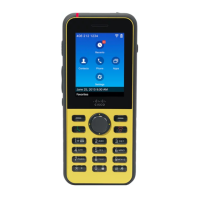The wireless phones have a single antenna and use the Single Input Single Output (SISO)
system, which supports MCS 0 to MCS 7 data rates only (72 Mbps with 20 MHz channels
and 150 Mbps 40 MHz channels). Optionally, you can enable MCS 8 to MCS 15 if
802.11n clients are using MIMO technology that can take advantage of those higher
data rates.
Note
•
802.11r: Specifies requirements for fast secure roaming.
•
802.11ac: Uses the radio frequency of 5 GHz for both transmission and receipt of data with speeds up
to 433 Mbps.
Table 4: Supported Channels
Channel WidthChannel SetAvailable
Channels
Band Range
20 MHz1 - 13132.412 - 2.472 GHz
20, 40, 80 MHz36, 40, 44, 4845.180 - 5.240 GHz
20, 40, 80 MHz52, 56, 60, 6445.260 - 5.320 GHz
20, 40, 80 MHz100 - 140115. 500 - 5.700 GHz
20, 40, 80 MHz149, 153, 157, 161, 16555.745 - 5.825 GHz
Channels 120, 124, 128 are not supported in the Americas, Europe, or Japan, but may be in other regions
around the world.
Note
For information about supported data rates, Tx power and Rx sensitivity for WLANs, see the Cisco Wireless
IP Phone 8821 Series Deployment Guide.
World Mode (802.11d)
The wireless phones use 802.11d to determine the channels and transmit power levels to use. The phone
inherits its client configuration from the associated AP. Enable World mode (802.11d) on the AP to use the
phone in World mode.
Enablement of World mode (802.11d) may not be necessary if the frequency is 2.4 GHz and the current
access point is transmitting on a channel from 1 to 11.
Note
Because all countries support these frequencies, you can attempt to scan these channels regardless of World
mode (802.11d) support.
Cisco Wireless IP Phone 8821 and 8821-EX Administration Guide for Cisco Unified Communications Manager
24
VoIP Networks
World Mode (802.11d)

